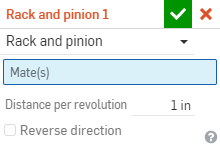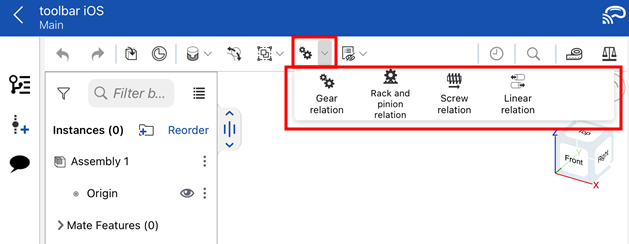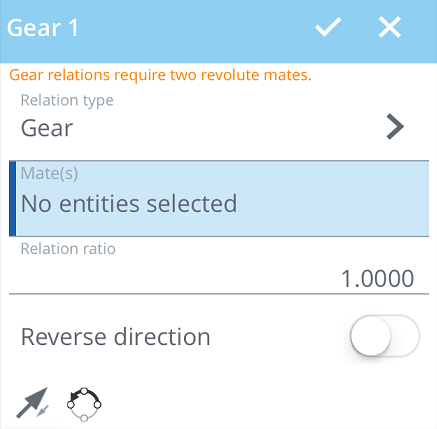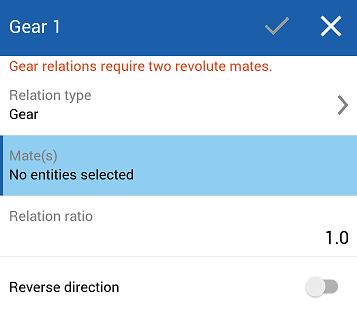Relations
![]()
![]()
![]()
Use relations on mates to constrain degrees of freedom between mates.
Types of relations
Onshape currently offers these types of relations:
- Gear Relation - Relate two mates with revolute degrees of freedom
- Rack and Pinion Relation - Relate a mate with rotational degree of freedom to a mate with linear degree of freedom
- Screw Relation - Constrain the rotational degree of freedom in one cylindrical mate to the translational degree of freedom in the same cylindrical mate
- Linear Relation - Constrain the linear motion between two mates to change at a constant ratio
Use relations on mates to constrain degrees of freedom between mates. Onshape currently offers these types of relations:
Steps
To add a relation:
- Select one of the relation icons.
- Select the required mates you want to constrain in the main list of mate features (or in the list of features in any of the current subassemblies).
- In the relation dialog, confirm that the desired type of relation is selected:

- Select the required mates either on the model or from the Mate Features list.
-
Specify degree of freedom for the mate, if necessary:
- When you select mates with the exact degrees of freedom required by the relation, Onshape displays the degree of freedom in the dialog for each mate.
The icons indicate the specific degrees of freedom of each mate: linear movement along the Z axis for Slider, and revolving movement about the Z axis for Revolute.
- If you select mates with more degrees of freedom than required by the relation, a second dialog appears in which to select the desired degree of freedom for each mate selected.
- When you select mates with the exact degrees of freedom required by the relation, Onshape displays the degree of freedom in the dialog for each mate.
- Specify the distance per revolution (and units if not using the default units).
- Once the appropriate degrees of freedom are selected for both Mates, the dialog is populated and ready to be accepted.
You have the ability to use expressions and trigonometric functions in numeric fields in Assemblies.

Use relations on mates to constrain degrees of freedom between mates. Onshape currently offers these types of relations:
- Gear Relation - creates a constant ratio of angular rotation between mates
- Rack and Pinion Relation - relates the rotational degree of freedom of a revolute mate with the linear degree of freedom of a slider mate
- Screw Relation - constrains the rotational degree of freedom in one cylindrical mate to the translational degree of freedom in the same cylindrical mate
- Linear Relation - constrains the linear motion between two slider mates to change at a constant ratio
Steps
To add a relation:
- Select one of the relation icons.
- Select the required mates you want to relate in the main list of mate features (or in the list of features in any of the current subassemblies),
- In the relation dialog, confirm that the desired type of relation is selected and enter the required information.

The relation only succeeds if the mates chosen are appropriate for the type of relation chosen.
![]()
Use relations on mates to constrain degrees of freedom between mates. Onshape currently offers these types of relations:
- Gear Relation - creates a constant ratio of angular rotation between mates
- Rack and Pinion Relation - relates the rotational degree of freedom of a revolute mate with the linear degree of freedom of a slider mate
- Screw Relation - constrains the rotational degree of freedom in one cylindrical mate to the translational degree of freedom in the same cylindrical mate
- Linear Relation - constrains the linear motion between two slider mates to change at a constant ratio
Steps
To add a relation:
- Select one of the relation icons.
- Select the required mates you want to relate in the main list of mate features (or in the list of features in any of the current subassemblies),
- In the relation dialog, confirm that the desired type of relation is selected and enter the required information.

The relation only succeeds if the mates chosen are appropriate for the type of relation chosen.